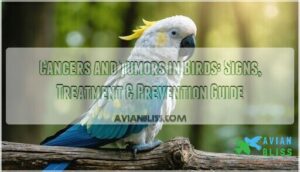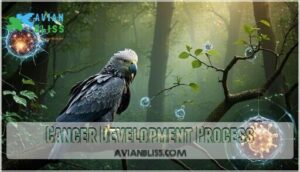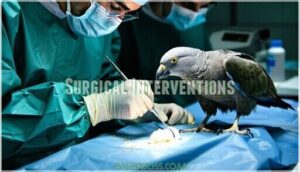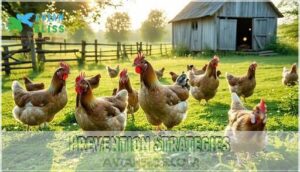This site is supported by our readers. We may earn a commission, at no cost to you, if you purchase through links.

You’ll notice symptoms including unexplained weight loss, difficulty breathing, changes in appetite, and visible lumps or swellings.
Early detection proves vital since avian cancers can progress rapidly.
Treatment options range from surgical removal to chemotherapy, though success rates vary by tumor type and location.
Prevention focuses on maintaining proper nutrition, reducing environmental toxins, and ensuring regular veterinary checkups.
While some species show higher susceptibility to certain cancers, prompt intervention can substantially improve outcomes.
Understanding these warning signs could mean the difference between catching a treatable condition early and facing more complex challenges down the road.
Table Of Contents
- Key Takeaways
- Types of Avian Cancers
- Cancer Development Process
- Avian Cancer Symptoms
- Avian Cancer Treatment
- Prevention Strategies
- Frequently Asked Questions (FAQs)
- Is cancer common in birds?
- What does a tumor look like on a bird?
- Can birds recover from cancer?
- What is the most common tumor in birds?
- What are the symptoms of cancer in birds?
- What is the difference between tumor and cancer?
- Can birds transmit cancer to humans or other pets?
- How does avian cancer affect bird behavior and lifespan?
- Are certain bird species more resistant to cancer?
- What role do environmental toxins play in avian cancer?
- Conclusion
Key Takeaways
- Watch for early warning signs – you’ll spot symptoms like unexplained weight loss, difficulty breathing, visible lumps, and behavioral changes that could indicate cancer before it progresses
- Act quickly on detection – early intervention dramatically improves treatment outcomes since avian cancers can progress rapidly, making prompt veterinary attention crucial
- Consider surgical removal first – surgery offers the most direct path to eliminating tumors, though success depends on the tumor type and location in your bird’s body
- Focus on prevention strategies – you can reduce cancer risk through proper nutrition, regular veterinary checkups, minimizing environmental toxins, and maintaining optimal living conditions
Types of Avian Cancers
Avian cancers fall into three main categories that affect different parts of your bird’s body.
You’ll encounter internal organ cancers, external skin tumors, and benign growths that require distinct approaches for diagnosis and treatment, including external skin tumors.
Internal Cancers
Internal cancers in birds develop within essential organs and blood systems.
Avian leukemia affects the bloodstream, while lymphoma types target lymphatic tissues.
Bird brain tumors can disrupt neurological function, requiring specialized avian oncology studies for proper diagnosis.
Cancer staging helps determine treatment approaches, and internal tumors often remain hidden until advanced stages, making avian cancer research important for improving bird tumor treatment outcomes and developing reliable tumor markers for early detection.
Skin Cancers
Skin cancer in birds presents through various forms that affect external tissues.
Feather cysts appear as fluid-filled growths beneath feathers, while beak tumors develop on the hard keratin surface.
Skin lesions manifest as irregular patches or growths on exposed areas.
Avian melanoma affects pigmented cells, creating dark masses.
Fowl pox causes characteristic raised lesions on unfeathered skin areas like combs and wattles.
Birds with weakened immune systems are more susceptible to common bird diseases that can increase the risk of developing skin cancers.
Benign Tumors
Unlike malignant growths, benign tumors in birds don’t spread to other tissues.
You’ll commonly encounter fibromas, lipomas, adenomas, cysts, and papillomas in your feathered patients.
These growths typically remain localized and grow slowly.
While benign doesn’t mean harmless—they can still cause problems depending on location—most respond well to surgical removal.
Avian oncology research shows these tumor biology patterns differ markedly across species, making proper identification essential for effective treatment planning.
Cancer Development Process
Understanding cancer development in birds requires examining how genetic mutations, environmental stressors, and species-specific traits interact to trigger abnormal cell growth.
You’ll find that avian cancers follow similar cellular pathways to mammalian tumors, but with unique variations based on each bird’s evolutionary adaptations and lifespan characteristics, which can be considered as species-specific traits.
Genetic Factors
When genetic mutations accumulate in your bird’s DNA, they disrupt normal cellular function and trigger cancer development.
Bird genome variations influence tumor suppressor genes and protooncogenes, creating hereditary traits that predispose certain species to malignancy.
Avian oncogenes become activated through DNA repair gene dysfunction, altering gene expression patterns that control cell division and growth regulation.
Understanding psittacine beak disease can also provide insights into the genetic factors contributing to cancer development in birds.
Environmental Influences
When pollution effects meet vulnerable bird populations, the results spell trouble.
Toxic exposure from pesticides reaches concentrations 100,000 times higher than safe levels, while habitat loss forces birds into contaminated areas.
Climate change amplifies ecological stress, disrupting immune systems and triggering DNA damage.
Environmental factors create perfect storms for cancer development through chronic inflammation and oxidative stress pathways in avian tissues.
The impact of air pollution on birds can be understood by examining the air pollution risks.
Species-Specific Variations
Different bird species show varying cancer susceptibility patterns that you’ll want to understand for effective diagnosis and treatment.
**Understanding your bird’s species helps predict which cancers may develop and guides treatment decisions.
Poultry oncology research reveals significant differences in tumor development across avian families.
- Waterfowl develop more digestive tract tumors and avian mast cell tumors
- Raptors commonly present with beak cancers and liver malignancies
- Songbirds frequently exhibit feather tumors and skin carcinomas
- Poultry show higher rates of reproductive system cancers
Avian cancer research demonstrates that species differences influence both bird cancer diagnosis approaches and bird tumor removal success rates, making species-specific knowledge essential for veterinary oncologists.
Avian Cancer Symptoms
You’ll spot avian cancer symptoms through physical changes like unusual lumps, altered eating patterns, and behavioral shifts that persist beyond normal seasonal variations.
These signs often develop gradually, making regular observation of your bird’s appearance, weight, and activity levels essential for early detection, which involves monitoring for unusual changes.
Common Cancer Signs
You’ll notice several warning signs when cancer strikes your feathered friend. Early detection saves lives, so watch for these red flags carefully.
| Physical Signs | Behavioral Changes | Diagnostic Clues |
|---|---|---|
| Visible lumps or swellings | Decreased appetite and feeding changes | Abnormal droppings analysis results |
| Weight loss despite normal eating | Lethargy and reduced activity | Blood work showing cancer markers |
| Difficulty breathing or wheezing | Social withdrawal from flock | Imaging revealing tumor growth |
| Abnormal feather loss or growth | Changes in vocalization patterns | Biopsy confirming malignant cells |
These bird cancer symptoms often appear gradually. Avian cancer research shows that early bird cancer diagnosis improves treatment outcomes substantially.
Monitor your bird’s droppings analysis regularly, as changes indicate internal problems. Avian mast cell tumors frequently cause visible skin changes. Professional bird tumor removal requires immediate veterinary attention when these signs appear.
Species-Specific Symptom Variations
Your bird’s species determines which cancer markers you’ll spot first.
Budgerigars commonly show sudden blindness from pituitary adenomas, while chickens develop leg paralysis from kidney tumors.
Cockatiels display yellow, ulcerated xanthomas on their skin, and Amazon parrots develop hemangiomas appearing as swellings.
These species variance patterns help identify specific avian tumor types early through recognizable symptom patterns, and early detection often relies on understanding tumor characteristics to provide effective care for birds with tumors.
Avian Cancer Treatment
When your bird receives a cancer diagnosis, you’ll face several treatment options that can substantially impact their prognosis and quality of life.
Your veterinary oncologist will develop a customized treatment plan based on the tumor type, location, and your bird’s overall health status.
Surgical Interventions
Surgery offers the most direct path to eliminating tumors in birds.
Tumor removal requires precise techniques due to avian anatomy’s unique challenges.
Beak reconstruction restores function after oral tumor excision.
Feather repair addresses localized skin cancers affecting flight capabilities.
Wing amputation becomes necessary when tumors compromise structural integrity.
Surgical intervention demands specialized avian pathology expertise and advanced oncology research protocols.
The success of these procedures often relies on specialized avian surgery tools to guarantee precise tumor removal.
Chemotherapy and Radiation
Avian oncology faces unique challenges when treating cancer with traditional therapies.
Chemotherapy options remain limited due to birds’ rapid metabolism and high toxicity rates.
Response rates stay below 30% for most malignancies.
- Cyclophosphamide, vincristine, and doxorubicin adapted from mammalian protocols
- Radiation therapy achieves 40-70% response rates in superficial tumors
- Fractionated external beam radiation minimizes tissue damage
- Combination treatments increase efficacy but raise systemic toxicity risks
- Species-specific dosing required due to different pharmacokinetics
Avian cancer patients are also prone to developing respiratory disease issues that can complicate their treatment and recovery, which can be found at respiratory disease issues.
Alternative Therapies
While conventional treatments remain primary, complementary therapies show promise in avian medicine.
Acupuncture may reduce pain and inflammation in affected birds. Herbal remedies like milk thistle support liver function during treatment.
Nutrition therapy optimizes immune response through targeted diets. Homeopathy offers gentle symptom management.
These cancer integrative medicine approaches supplement traditional protocols, requiring veterinary supervision for safe implementation. The use of acupuncture therapy can be a valuable component of a thorough treatment plan, supporting avian medicine and overall wellness.
Prevention Strategies
You can substantially reduce your bird’s cancer risk through early detection screenings and environmental management.
Regular veterinary checkups combined with proper housing, nutrition, and reduced toxin exposure create the foundation for effective cancer prevention strategies, which include early detection screenings.
Early Detection Methods
Three diagnostic approaches form your early detection toolkit.
Physical examination with palpation reveals external tumors you can spot during routine checkups. Blood tests and tumor markers help identify internal cancers before symptoms appear.
Diagnostic imaging techniques like radiographs and ultrasound locate hidden lesions, while biopsy methods provide definitive confirmation through cytology and histopathology for accurate cancer diagnosis.
Accurate bird cancer test kits are essential for identifying diseases in their early stages, using tumor markers and diagnostic imaging to ensure timely intervention.
Ecological Factors
Your bird’s environment shapes cancer risk through multiple pathways.
Habitat loss forces birds into contaminated areas with higher carcinogen exposure.
Climate change disrupts immune function, increasing disease susceptibility.
Key ecological cancer risks include:
- Habitat Loss – pushes birds toward polluted industrial zones
- Climate Change – weakens natural disease resistance mechanisms
- Food Chains – concentrate toxins through bioaccumulation processes
- Migration Patterns – expose birds to varied environmental carcinogens
Conservation medicine research shows wildlife health depends on ecosystem integrity.
Protecting nesting sites and natural corridors reduces avian disease research needs while supporting bird cancer treatment options through prevention-focused approaches.
Life History Traits
Considering growth patterns and reproductive strategies, your feathered friend’s life history traits substantially influence cancer susceptibility.
Fast-growing species with high mortality rates often develop more aggressive tumors, while long-lived birds show different aging process vulnerabilities.
Understanding survival rates helps predict which avian health problems emerge.
These patterns guide targeted bird cancer treatment options and preventive care strategies for ideal avian disease research outcomes.
Effective bird disease natural prevention methods, such as disease prevention strategies, are essential for maintaining the health and well-being of birds.
Evolutionary Perspectives
Millions of years of molecular evolution have shaped distinct adaptive traits across avian species through phylogenetic analysis.
Comparative oncology reveals how species divergence influences cancer resistance mechanisms in bird diseases.
Understanding these evolutionary perspectives helps veterinary oncology professionals develop targeted approaches for avian health management based on each species’ unique cancer biology adaptations, which is crucial for effective avian health management.
Frequently Asked Questions (FAQs)
Is cancer common in birds?
Like shadows lurking beneath feathers, cancer strikes our avian companions too.
You’ll find neoplasms aren’t uncommon in pet birds, particularly older ones.
Lymphomas, skin tumors, and reproductive cancers frequently affect species like budgies and cockatiels, requiring prompt veterinary attention to address lymphomas.
What does a tumor look like on a bird?
You’ll recognize tumors as unusual swellings or growths that feel firm under your bird’s skin.
They’re often round, irregular masses that can appear anywhere on the body, including wings, legs, or abdomen, varying in size and texture.
Can birds recover from cancer?
Time heals all wounds, but avian oncology presents unique challenges.
Your bird’s recovery depends on cancer type, stage, and treatment options.
Early detection improves outcomes substantially, and surgical removal, chemotherapy, and supportive care can extend quality life in many cases.
What is the most common tumor in birds?
You’ll find lipoma is the most prevalent neoplasm in birds, particularly affecting Amazona parrots and other psittaciform species. This benign fatty tumor commonly appears near the vent area.
What are the symptoms of cancer in birds?
You’ll notice weight loss, decreased appetite, and lethargy as early warning signs. Watch for unusual lumps, breathing difficulties, changes in droppings, or behavioral shifts that persist beyond normal patterns.
What is the difference between tumor and cancer?
Tumors are abnormal growths that can be benign or malignant, while cancer specifically refers to malignant tumors that invade nearby tissues and spread throughout your body.
Can birds transmit cancer to humans or other pets?
Ever wondered if your feathered friend’s illness could affect you?
Birds can’t directly transmit cancer to humans or other pets since cancer isn’t contagious like viruses or bacteria.
However, some cancer-causing viruses in birds theoretically pose minimal cross-species risk under specific circumstances.
How does avian cancer affect bird behavior and lifespan?
Cancer substantially alters your bird’s daily activities, causing lethargy, reduced appetite, and behavioral changes. You’ll notice shortened lifespans depending on tumor type and location, with early detection improving outcomes substantially.
Are certain bird species more resistant to cancer?
You’ll find varying resistance levels across species due to genetic differences and evolutionary adaptations.
Long-lived seabirds like gulls show enhanced cancer-defense mechanisms, while species with higher reproductive rates display increased cancer susceptibility.
What role do environmental toxins play in avian cancer?
Like silent sentinels in polluted skies, environmental toxins substantially impact avian cancer development.
You’ll find that heavy metals, pesticides, and industrial chemicals disrupt cellular DNA repair mechanisms, increasing tumor formation rates in bird populations exposed to contaminated habitats, which can lead to a significant increase in tumor formation.
Conclusion
Addressing the delicate area of cellular irregularities requires vigilance and swift action.
You’ve learned that cancers and tumors in birds present complex challenges requiring immediate attention.
Early detection remains your strongest weapon against these conditions.
Surgical removal offers hope for accessible tumors, while chemotherapy provides options for advanced cases.
Prevention through proper nutrition and environmental management substantially reduces risk.
Regular veterinary examinations enable prompt intervention when abnormalities arise.
Your commitment to monitoring behavioral changes and physical symptoms directly impacts treatment success rates and overall prognosis.
- https://www.chewy.com/education/bird/general/lumps-and-tumors-in-birds
- https://pmc.ncbi.nlm.nih.gov/articles/PMC7149733/
- https://www.petmd.com/bird/conditions/cancer/c_bd_Cancers_and_Tumors
- https://news.asu.edu/20240730-science-and-technology-asu-researchers-explore-cancer-susceptibility-birds
- https://www.world-budgerigar.org/article10.htm










